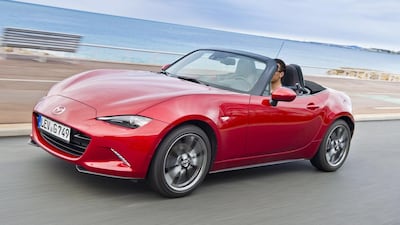When Mazda created the MX-5 in 1989, it famously took its inspiration from the classic British lightweight sports cars of the 1950s and 1960s; most notably, the Lotus Elan. It took so much inspiration, some accused the Japanese carmaker of lazily copying the sports-car formula. However, such doubters were soon silenced by the simple brilliance of that front-engined, rear-drive original.
Looking back now, it’s hard to think that any people criticised the MX-5 at all, because it has since gone on to shift 950,000 units worldwide in a little more than 25 years, making it the best-selling roadster in history. And as the time has come to replace the mk 3 example, Mazda no longer has to copy anyone else. It has gone back to the drawing board, looked at that pioneering model and – in the words of Colin Chapman – added lightness.
Like so many cars, the MX-5 has got a bit tubby over the years. Certainly not as bloated as some rivals, sure, but the outgoing mk 3 was no longer the lithe, athletic machine that the original was. But this mk 4 car, due to go on sale later this summer, is the lightest MX-5 since the mk 1. There are two engines (market depending) to go for, both normally aspirated, four-cylinder petrol motors of either 1.5L or 2.0L, but opt for the former and you get a sub-tonne sports car, the MX-5 weighing in at 975kg. That’s phenomenal stuff, achieved through the use of a lot of aluminium and the sort of fastidious engineering attention to detail that sees every superfluous gram of metal shaved off in the pursuit of skinniness.
It looks fantastic, too, which is half the battle in tempting roadster buyers into showrooms, with a short front overhang and low nose, which necessitates the use of the small LED headlamp units. There’s a lovely, sweeping shoulder line to the MX-5, and it resolves into a tidy rear end, although it’s heavily reminiscent of Jaguar’s F-Type, with the round brake lamps in otherwise slimline light clusters.
The interior isn’t as striking in terms of aesthetics, and indeed compared to some of Mazda’s other products, it’s not as impressive. But there’s cleverness and the pursuit of driving perfection everywhere to be found within. For instance, both occupants sit 20 millimetres lower than before and 15mm closer to the car’s centre line, to improve the centre of gravity. It makes you feel as though you are utterly ensconced by the Mazda’s chassis. Furthermore, the driver looks at an array of dials and controls symmetrically arranged around a wonderful, thin-rimmed steering wheel – the idea being to make the driver the focal point of the vehicle. The hood is manual, but it’s so light in operation that it can be done one-handed without straining.
On the move, the MX-5’s lack of mass permeates everything it does. While neither 131hp nor 150Nm are huge amounts in today’s world, they’re more than enough for 975kg. The Mazda feels lively in terms of acceleration, with 0 to 100kph in 8.3 seconds (the 2.0L cuts this by a second, and also raises top speed from 204kph to 214kph). But what really appeals is the noise. This unit sings a lovely, hard-edged song, unadorned by any need for augmentation. It also likes to rev, peak power coming at 7,000rpm, and the limiter is 500rpm beyond that. It remains free-spinning and smooth throughout. It’s paired to one of the finest six-speed manual transmissions you could hope to encounter, the gearbox possessing a superb, mechanical shift action that’s a delight to use. The electric power steering is another gem, full of feel, pin sharp and yet without needless, artificial weight.
The ride is even magnificent, all elasticity and comfort, which is a huge surprise from something featherweight and on a short wheelbase, but it has another benefit – incredible roadholding. There’s more roll on the 1.5L MX-5 than on the 2.0L (which gets sports suspension and a limited-slip differential in some markets), but that means the Mazda pushes more of its 16-inch rubber into the tarmac to offer up massive grip.
True, it’s not a car that is easy to power oversteer, especially in the dry, and there’s some understeer to overcome, but most of the time it has neutral balance, allowing you to get on with the job of dissecting corners with a massive smile on your face.
It takes a brave company, in this day and age where personalisation is everything, to offer a car without adjustable dampers, multi-mode steering or button-selectable throttle maps, but Mazda – in going back to the MX-5’s stripped roots – has created a thoroughly cohesive, enjoyable drivers’ car, because it has executed all of its “fixed” dynamic parameters to perfection.
That it also has sharp looks, light build, affordable pricing and decent standard equipment only makes me love it even more. The new Mazda MX-5 proves that if you take one step back, sometimes you can then make two giant leaps forward.
motoring@thenational.ae

